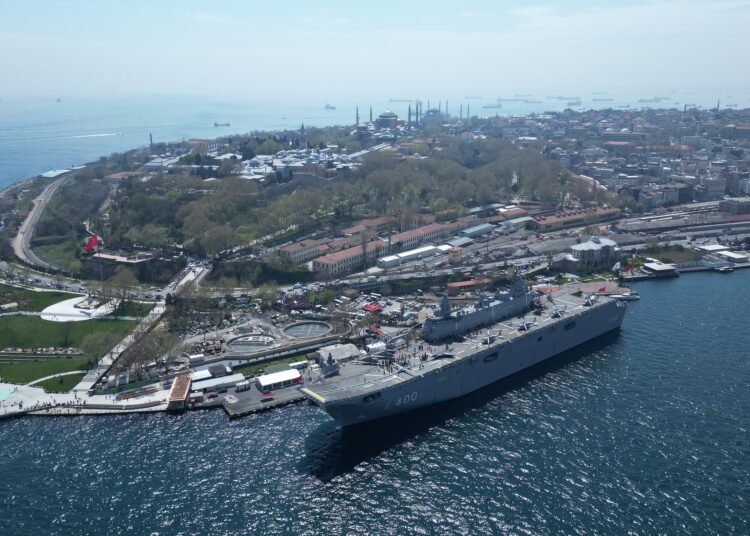Levent Kenez/Stockholm
During a gathering of his ruling party’s lawmakers on Wednesday, Turkish President Recep Tayyip Erdogan announced the commencement of preparations for the construction of a new generation aircraft carrier for Turkey. Erdogan had mentioned an agreement with Spain for new flagship construction during the 100th anniversary celebrations of the Turkish Republic on October 29.
Emphasizing that the new vessel, developed in collaboration with Spain, would surpass Turkey’s largest naval ship, the TCG Anadolu, Erdogan claimed that a robust military is essential for Turkey to survive in the region. Erdogan has alternately referred to TCG Anadolu as both an aircraft carrier and the first ship in the world from which unmanned aerial vehicles (UAV) take off and land. However, despite Erdogan’s assertions, military experts point out that the ship is neither the world’s first on which drones are deployed nor a conventional aircraft carrier. Despite the misinformation, Erdogan continues to repeat it in his speeches.

Highlighting the significance of a naval parade featuring 100 ships in the Bosporus on October 29, Erdogan said the event conveyed important messages and symbols. “Through that ceremony, which instilled confidence in our friends and fear in our adversaries, we had the opportunity to witness the capabilities of our navy. In particular we saw how the world’s first UAV ship, TCG Anadolu, added strength to our navy. Of course, we are not satisfied with just that. We have rolled up our sleeves to build a new generation aircraft carrier, the big brother of TCG Anadolu.”
However, in an interview with a Turkish TV station on May 18, İsmail Demir, the former head of the Presidency of the Defense Industry (Savunma Sanayii Baskanligi, SSB), Turkey’s defense procurement agency, said some modifications must be made to TCG Anadolu to accommodate both manned and unmanned aircraft as well as aircraft in the military’s inventory so that they can take off from and land on the ship, confirming accusations that the government had commissioned the ship early in order to promote it in the May 14 elections.
On November 4, in a speech to businesspeople, Selçuk Bayraktar, Erdogan’s son-in-law and the owner of Baykar Makina, the manufacturer of Bayraktar military drones, revealed that flight tests for the newly developed TB3 drones had been conducted. He stated that once deployed on the TCG Anadolu, these drones would become a significant force multiplier, essentially admitting that military drones are not currently capable of taking off and landing on the ship.
TCG Anadolu is the largest ship in the Turkish Navy, with a length of 231 meters, a width of 32 meters and a displacement of 27,436 tons. The ship has a top speed of 20.5 knots and a range of 9,000 nautical miles when fully loaded. The construction of the vessel began in April 2016, and the keel was laid in February 2018. The ship carries out tasks such as military combat and humanitarian relief operations. Furthermore, it acts as a command center and the navy’s new flagship. TCG Anadolu was designed by Spain’s Navantia and built at the Sedef Shipyard in Turkey. Sea acceptance tests started in June 2022.

Anadolu, actually a multi-purpose amphibious assault ship, became the latest showcase product in Erdogan’s election propaganda in May. One of Erdogan’s election strategies was to show voters that Turkey was becoming stronger by promoting domestically produced defense industry products.
Erdogan announced on April 23 that the UK and Spain were cooperating in the construction of a more advanced version of the Turkish Navy’s flagship. He also claimed the British sought to benefit from Turkey’s experience in the construction of an unmanned submarine. Speaking to the London-based Middle East Eye, which is close to the Turkish government, a Turkish source said the UK is interested in the joint production of unmanned submarines with Turkey.
However, a spokesperson for the Royal Navy told Breaking Defense in a statement that “no one knows anything of these [Turkish] discussions,” including teams from the UK’s Submarine Delivery Agency, Defence Nuclear Organisation and shipbuilder BAE Systems.












